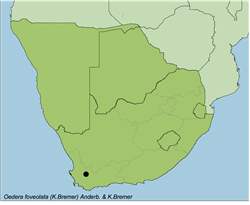Names and synonyms
Oedera foveolata (Bremer) Anderberg & Bremer
= Relhania foveolata Bremer
Type
Hafstr�m & Acocks 1721, stony slopes at Karoo Poort, 1938 (S, PRE).
Derivation of names
Oedera = after George Christian Oeder (1728-1791), professor of Botany in Copenhagen, author of Flora Danica
foveolatus = slightly pitted, with a small depression or pit
Diagnostic characters
Leaves with pitted glands
Capitula about 7 mm long
Shrubs profusely branched in upper paer, densely leafy
Leaf tips rounded
Description
A moderately branched shrulet, up to c. 0.5 m high. Stems ascending-erect, glabrous, leafy, becoming nude and marked with leaf-scars. Leaves alternate, spreading, somewhat semiterete, mid-ribbed, linear or narrowly obovate-oblong, 3-8 x 0.8-1.5 mm, glabrous, densely and distinctly glandular-punctate and foveolate, obtuse. Capitula solitary, sessile, terminal. Involucre bell-shaped, 6-8 mm wide. Involucral bracts 50-60, outer ovate, inner gradually longer and oblong and apically brown, innermost narrowly obovate with a spreading, brown apical limb, up to 6 x up to 1.3 mm, acute-obtuse. Receptacle convex, paleate. Paleae canaliculate, linear, 5-5.5 x 0.3-0.5 mm, dorsally sparsely gland-dotted, acute. Ray florets 20-25, tube 1.5-2 mm long, lamina elliptic-oblong, 5-6 x 1.2-1.8 mm, yellow and dorsally with a brownish purple stripe, 4-veined. Disc florets >40, perfect. Pappus crownlike, of � connate scales, up to 1.3 mm long. Cypsela almost terete, elliptic-oblong, 1.2-1.5 x 0.4-0.5 mm, pilose; much more densely pilose in ray florets.
Flowering time
September to December.
Distribution
Only known from one locality: Karoo Poort.
Habitat
Rocky slopes, hillsides.
Notes
Related to O. sedifolia but differs by the bell-shaped involucres, smaller and much more pilose cypselas and distinctly foveolate leaves.
References
GLEN, H.F. 2004. SAPPI, What's in a Name? The Meanings of the Botanical Names of Trees. Jacana.
HARVEY. 1865. Compositae in: W.H. Harvey & O.W. Sonder. Flora Capensis 3 (ed. 1). Hodges & Smith, Dublin.
SMITH, C. A. 1927. Four interesting species of Compositae. Bothalia 2: 360-365.
PHILLIPS.1940. The Flowering Plants of South Africa 20: t. 786
KESTING, D. & CLARKE, H. 2008. Botanical names, what they mean. Wild Flowers of the Cape Peninsula, 3rd revised edition. Friends of Silvermine.
BREMER, K. 1976. The genus Relhania (Compositae). Opera Botanica 40.
ANDERBERG, A.A. & BREMER, K. 1991. Parsimony analysis and cladistic reclassification of the Relhania generic group (Asteraceae - Gnaphalieae). Annals of the Missouri Botanical Garden 78: 1061-1072.
GOLDBLATT, P. & MANNING, J.C. 2000. Cape Plants. A conspectus of the Cape flora of South Africa. Strelitzia 9. SANBI.
